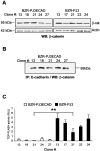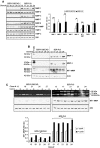E-Cadherin mediates MMP down-regulation in highly invasive bronchial tumor cells
- PMID: 12875984
- PMCID: PMC1868220
- DOI: 10.1016/S0002-9440(10)63692-9
E-Cadherin mediates MMP down-regulation in highly invasive bronchial tumor cells
Abstract
The disorganization of E-cadherin/catenin complexes and the overexpression of matrix metalloproteinases (MMPs) are frequently involved in the capacity of epithelial cells to acquire an invasive phenotype. The functional link between E-cadherin and MMPs was studied by transfecting invasive bronchial BZR tumor cells with human E-cadherin cDNA. Using different in vitro (cell dispersion, modified Boyden chamber) and in vivo assays (human airway epithelial xenograft), we showed that E-cadherin-positive clones displayed a decrease of invasive abilities. As shown by immunoprecipitation, the re-expressed E-cadherin was able to sequestrate one part of free cytoplasmic beta-catenin in BZR cells. The decrease of beta-catenin transcriptional activity in E-cadherin-transfected clones was demonstrated using the TOP-FLASH reporter construct. Finally, we observed a decrease of MMP-1, MMP-3, MMP-9, and MT1-MMP, both at the mRNA and at the protein levels, in E-cadherin-positive clones whereas no changes in MMP-2, TIMP-1, or TIMP-2 were observed when compared with control clones. Moreover, zymography analysis revealed a loss of MMP-2 activation ability in E-cadherin-positive clones treated with the concanavalin A lectin. These data demonstrate a direct role of E-cadherin/catenin complex organization in the regulation of MMPs and suggest an implication of this regulation in the expression of an invasive phenotype by bronchial tumor cells.
Figures







Similar articles
-
E-cadherin suppression accelerates squamous cell carcinoma progression in three-dimensional, human tissue constructs.Cancer Res. 2005 Mar 1;65(5):1783-91. doi: 10.1158/0008-5472.CAN-04-3399. Cancer Res. 2005. PMID: 15753375
-
Membrane-type 1 matrix metalloproteinase expression is regulated by zonula occludens-1 in human breast cancer cells.Cancer Res. 2005 Sep 1;65(17):7691-8. doi: 10.1158/0008-5472.CAN-04-4230. Cancer Res. 2005. PMID: 16140936
-
Quantitative cell dispersion analysis: new test to measure tumor cell aggressiveness.Int J Cancer. 2001 Sep 1;93(5):644-52. doi: 10.1002/ijc.1380. Int J Cancer. 2001. PMID: 11477573
-
Downregulation in vivo of the invasion-suppressor molecule E-cadherin in experimental and clinical cancer.Princess Takamatsu Symp. 1994;24:63-80. Princess Takamatsu Symp. 1994. PMID: 8983064 Review.
-
Regulation of the invasion suppressor function of the cadherin/catenin complex.Pathol Res Pract. 1996 Jul;192(7):694-707. doi: 10.1016/S0344-0338(96)80091-4. Pathol Res Pract. 1996. PMID: 8880870 Review.
Cited by
-
Targeting NF-κB mediated cell signaling pathway and inflammatory mediators by 1,2-diazole in A549 cells in vitro.Biotechnol Rep (Amst). 2021 Jan 28;29:e00594. doi: 10.1016/j.btre.2021.e00594. eCollection 2021 Mar. Biotechnol Rep (Amst). 2021. PMID: 33598414 Free PMC article.
-
Prolactin-induced tyrosyl phosphorylation of PAK1 facilitates epithelial-mesenchymal transition.MicroPubl Biol. 2024 Apr 9;2024:10.17912/micropub.biology.001136. doi: 10.17912/micropub.biology.001136. eCollection 2024. MicroPubl Biol. 2024. PMID: 38660565 Free PMC article.
-
Escherichia coli induced matrix metalloproteinase-9 activity and type IV collagen degradation is regulated by progesterone in human maternal decidual.BMC Pregnancy Childbirth. 2024 Oct 4;24(1):645. doi: 10.1186/s12884-024-06847-8. BMC Pregnancy Childbirth. 2024. PMID: 39367340 Free PMC article.
-
Snail regulates Nanog status during the epithelial-mesenchymal transition via the Smad1/Akt/GSK3β signaling pathway in non-small-cell lung cancer.Oncotarget. 2014 Jun 15;5(11):3880-94. doi: 10.18632/oncotarget.2006. Oncotarget. 2014. PMID: 25003810 Free PMC article.
-
Corneal proteome and differentially expressed corneal proteins in highly myopic chicks using a label-free SWATH-MS quantification approach.Sci Rep. 2021 Mar 9;11(1):5495. doi: 10.1038/s41598-021-84904-4. Sci Rep. 2021. PMID: 33750851 Free PMC article.
References
-
- Takeichi M: Cadherin cell adhesion receptors as a morphogenetic regulator. Science 1991, 251:1451-1455 - PubMed
-
- Aberle H, Schwartz H, Kemler R: Cadherin-catenin complex: protein interactions and their implications for cadherin function. J Cell Biochem 1996, 61:514-523 - PubMed
-
- Wijnhoven BPL, Dinjens WNM, Pignatelli M: E-cadherin-catenin cell-cell adhesion complex and human cancer. Br J Surg 2000, 87:992-1005 - PubMed
-
- Bremnes RM, Veve R, Hirsch FR, Franklin WA: The E-cadherin cell-cell adhesion complex and lung cancer invasion, metastasis, and prognosis. Lung Cancer 2002, 36:115-124 - PubMed
Publication types
MeSH terms
Substances
LinkOut - more resources
Full Text Sources
Research Materials
Miscellaneous

